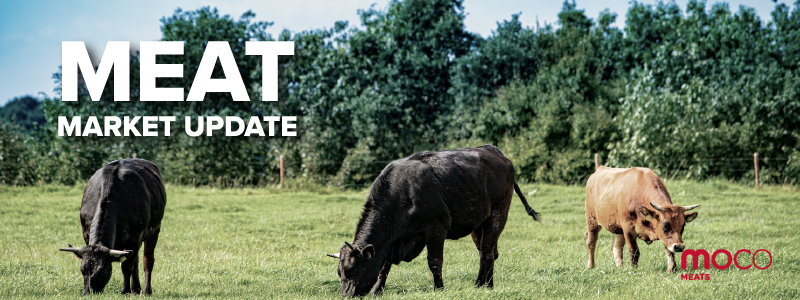Meat Market Update

We are seeing the results of the global protein shortages with an increased demand for Australian protein both locally and internationally. Whilst demand is very high, supply is struggling to catch up, there are a number of contributing factors as to why supply has been impacted from a weaker Australian dollar which makes Australian protein even more attractive to challenges with processing staff levels and costs of production and livestock numbers at certain specifications are creating an ever-evolving protein market that is adding pressure on breed specific programs, brands and consistency in availability at times. Due to recent events several producers are now playing catch up to meet demand and ensure continuity of supply.
Beef
- The number of cattle currently being processed has reduced dramatically on normal weekly volume nationally. This has affected non-grain fed products due to availability and production costs to process. Production staff shortages and the residual effects of COVID continue to impact numbers at primary producers combined with environmental impacts.
- It is inevitable we will see some pressure on the grain market which will have an onflow effect through primary processing and production.
- Due to the delayed and fractured start to 2022 production year, an increased number of larger cattle are coming through than typically seen at this time of year which undoubtedly has an affect on the portion business.
- Cattle numbers are impacting certain breeds, specifications, and brands whilst farmers continue to restock herds following several years of environmental impacts.
- Increased demand internationally has put further strain on beef availability with countries coming out of extended lockdowns. As a result, Australian beef is in high demand due to its reputation as a clean green food production environment on the international market, which has seen an increase in demand helped along by a weaker $AUD.
Chicken
- COVID related shortages are still having an impact on several production facilities and their ability to produce value-added and portioned products. Several production facilities in Southeast Queensland have been suffering from considerable staff shortages, with available processing staff impacted.
- With the Increased demand forecasted for Australian grain products and the increased cost of producing, it will undoubtedly put pressure on poultry production moving forward.
Lamb
- Rain in essential lamb producing areas should improve availability in the coming months if production facilities can avoid significant staff shortages.
- Australian Lamb Market is starting to improve, although recent weather events have impacted supply and transport from key Lamb Producing areas. At the same time, international demand from the Middle East, North Africa and Central Asia has created some challenges for the domestic market.
Recent rain should help with lamb availability in the coming months as production facilities move to the usual numbers. However, production capacity will depend on staffing availability.
Pork
- Staff shortages at several processing plants production facilities still impact supply in certain areas.
- Pork bellies, legs, and collar butts although ever popular will increase in demand in the coming months as we move closer to Easter and the cooler months.
- Pork numbers are relatively stable at present; however, with the forecasted pressure on the grain market we will monitor this closely to avoid any major impacts.